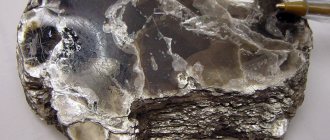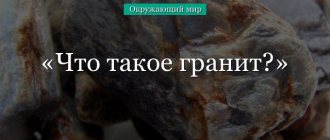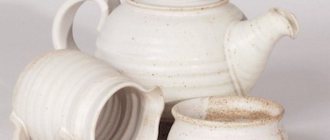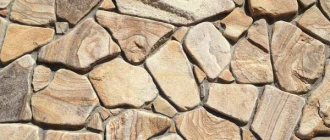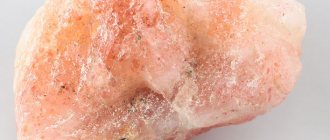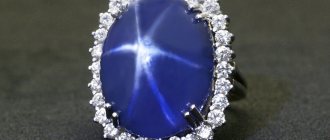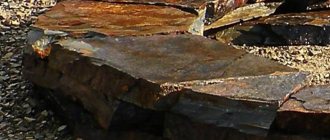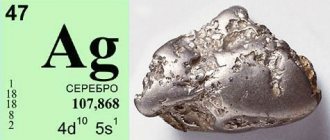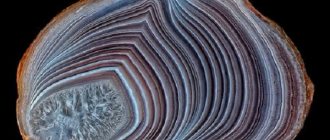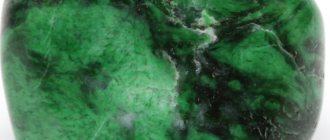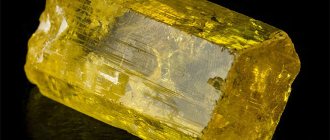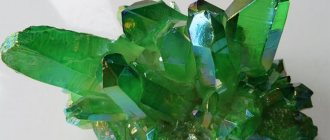Soapstone (soapstone, soapstone, waxstone, icestone, wen, tulikivi) is one of the most unusual gemstones.
Soapstone is actually dense talc, which is why this gemstone is sometimes called “soapstone.”
But the main feature of steatite is different - this stone is so smooth to the touch that it feels like it is greasy. For this property, steatite was called “wen”, “wax stone”, “soap stone” and “ice stone”.
However, it is a very soft stone (you can practically draw with it like chalk), therefore, although this precious stone has been known to mankind for a long time, it was used only for carving figurines and various utensils.
The color of soapstone is usually white, yellowish, gray, brown with a greenish tint. Less common are red or cherry colored soapstones.
Now, however, there is technology that makes it a very strong stone - this happens when the stone is heated to 1000 degrees. Then the soapstone becomes so hard that it can be used to cut glass.
Medicinal properties
Residents of Finland consider soapstone their national stone and call it “tulikivi” - “hot stone”. The Finns gave this name to steatite not by chance. The mineral has high heat resistance. It is an ideal fireproof material that heats up quickly and cools down slowly. A piece of soapstone, immersed in hot water for just 5 minutes, cools down within an hour! Thanks to this property, soapstone is a natural heating pad. In Finnish and Karelian medicine, steatite is used to treat radiculitis, sciatica, osteochondrosis, traumatic joint injuries and other similar diseases, for the treatment of which uniform and prolonged heating is useful. Mineral heating pads are made from steatite, convenient for use at home. It has been established that steatite also has strong energetics with a vibration frequency close to the vibrations of the brain. This property of steatite underlies the work of biostimulants that are made from this unique mineral.
What is soapstone
In geological sciences, the term soapstone is used to refer to soapstone. In everyday life, steatite is called based either on the appearance, properties of the mineral, or on the scope of application: wen, waxstone, stove stone, talc stone, ice stone, pot stone. In Finland it is a national treasure, called hot or “tulikivi”.
The surface of steatite is smooth, slippery with a matte velvety sheen. One gets the impression that the mineral is covered with a greasy layer and is about to jump out of your hands like soap. The peculiarity of the mineral is that with increased hardness it is able to leave a mark on the surface, like chalk.
The color range is wide: white, grayish-green, brown, gray and various red shades (from light to dark cherry).
Saponite is a variant of steatite. Refers to clay minerals, soft and greasy to the touch. Once dry, it becomes very brittle.
Watch a video review about the stone and its meaning:
Where are they most often used?
Such stones are especially in demand in the restaurant business. Thanks to them, establishment owners can reduce the burden on staff. It is enough to serve customers heated stones along with pre-prepared products and explain the principle of operation. Visitors themselves receive aesthetic pleasure from the process of preparing their favorite dishes themselves.
Interesting! Some restaurateurs are introducing dishes prepared using the stone grill method to attract new customers and retain old ones. Experience has shown that adding steaks and other stone-fried dishes to the menu increases restaurant traffic.
Frying stones are also in demand among owners of grills and barbecues. These accessories expand the chef's capabilities, giving more room for experimentation. Moreover, many connoisseurs make a heated stone the central element of a friendly get-together, during which everyone can fry meat, fish or vegetables to their liking.
Another nice feature for lovers of grilled meat is the ability to use the stone in camping conditions. For example, for frying over a fire.
Origin and deposits of the mineral
Rock deposits are scattered throughout the planet, formed in layers under high temperature and pressure as tectonic plates converge.
The structure of the mineral and its properties are influenced by climatic conditions, so the scope of application depends on the rock deposits. Northern countries are characterized by hard, fire-resistant samples of the mineral. In the European part, soapstone is more fragile.
The softest breeds are found in China, Thailand, and Africa. In Russia, the mineral has been mined since the beginning of the 18th century in Karelia, and was later discovered in the Urals. Saponite is obtained in Scotland, USA, Canada.
Areas of application
Thanks to its versatile properties, soapstone is widely in demand not only in crafts, but also in the industrial industry.
Construction
Crushed and ground soapstone of technical quality is a raw material for refractories, cement compositions, and electrical insulators.
Soapstone is used to line the walls of residential buildings and swimming pools, and to install “warm floors”. Soapstone is also an excellent soundproofing material.
Arrangement of baths and saunas
Soapstone crushed for baths
Due to its high heat capacity and thermal conductivity, the mineral is used in the construction of baths, steam rooms and saunas. Stone blocks used in baths look aesthetically pleasing, reliable and environmentally friendly.
Drink stones
Soapstone quickly not only accumulates heat, but also cools. In status circles, it is used instead of ice cubes to quickly cool a drink without diluting it with water. To do this, the treated soapstone cubes are placed in the freezer for several hours, after which they are used for their intended purpose. Used pebbles are washed under running water and dried.
Decor
Protective amulet with the Algiz rune, soapstone
Soapstone is plastic and easy to process, so it makes beautiful decorative elements. Vases, figurines, animal figurines, boxes, and souvenirs are made from the mineral. Due to its high thermal conductivity, dishes made of soapstone are in demand. Food cooked in a pot or frying pan made from this stone remains warm for a long time.
Decorations
The stone is not popular among jewelers due to its excessive softness. However, it makes unusual jewelry, set in cupronickel or silver - beads, pendants, pendants.
How to spot a fake
Soapstone (steatite) is an inexpensive mineral; there is no point in imitating it. However, the best specimens look like jade, which is what unscrupulous traders take advantage of. By tinting items made from soapstone, they are passed off as jade.
To recognize deception, you need to remember the properties of both minerals:
- soapstone is much softer than jade; mechanical stress leaves scratches on it;
- If soapstone is passed over the surface, a mark will remain on it.
Soapstone in astrology
Amulet made of soapstone
When choosing soapstone as a magical amulet or talisman, you should take into account its compatibility with the zodiac:
- The stone is ideal for Gemini, Pisces, Virgo and Libra. Representatives of these zodiac signs will gain calm and self-confidence, and get rid of their inherent fears and anxieties.
- Scorpios, Aquarius, Cancers and Capricorns can use soapstone, but not all the time. Otherwise, they may lose vigilance and confidence in their abilities.
- Taurus, Leo, Sagittarius and Aries are not recommended to wear this stone, as it negatively affects their character. Such negative qualities of these zodiac signs as ambition, selfishness and irritability increase several times when in contact with soapstone.
Physico-chemical characteristics
Soapstone is a magnesium silicate with a complex, constantly changing chemical composition. It consists of three independent minerals - talc, magnesite and chlorite. The main share in the composition of soapstone is magnesite and talc - 40-50% each. The proportion of chlorite, depending on the location of extraction, can reach 8%.
Main characteristics of the mineral:
| Index | Description |
| Formula | Mg₃[(Si, Al)₄O₁₀](OH)₂ × Mg₃(OH)₆ |
| Mohs hardness | 2-3 units |
| Density | up to 3.2 g/cm³ |
| Thermal conductivity | 3.3 W |
| Specific heat | 0.98 kJ/(kg x K) |
| Shine | matte, greasy |
| Transparency | opaque |
| Melting temperature | 1640°C |
Soapstone has a discreet gray color with inclusions of white, green, brown, blue and yellow shades. Specimens of red and cherry color are considered rare.
Perelivt (Shaitansky) - a truly Russian stone
This gem has an extraordinary “appearance” and many names: overflow agate, Ural agate, Shaitan overflow. Overflow stone is considered an ornamental stone, but it is so beautiful and endowed with so many useful properties that connoisseurs simply buy it.
Story
The mineral was discovered at the end of the 18th century by the courtier of Catherine II, Alexander Razderishin.
This happened in the Middle Urals, near the village of Shaitanki. The deposit gave the stone its name - Shaitan overflow.
The Empress favored Russian ore exploration, tried herself as a master stone cutter, and made large orders to the Yekaterinburg lapidary factory.
The peak of popularity of overflowing occurred during the reign of Empress Catherine II.
For the nobility, they made things that adorned life: powder boxes, bonbonnieres, snuff boxes, boxes, table cutlery.
In the Urals, gems were actually lying underfoot; they could be found on a plowed field or a washed-out river bank.
Shaitan overflow
After Catherine there were no connoisseurs. The Soviet government also did not understand the significance of the stone: mega-reserves of deposits became the “asphalt” of large highways, as a result of which they were quickly depleted.
Today, interest in the gem is being revived.
Description
Externally, the overflow looks like agate. Even academician A.E. Fersman considered it a variety of this stone.
However, this is not overflowing agate, but a layered alternation of quartz, quartzine and dickite:
- Overflow is an opaque (sometimes translucent) variety of Ural quartz, in which colored layers (up to 7-8 mm thick) gently flow and flow.
- The colors of Ural stone range from white-bluish to sunny (yellowish, orange, red). The yellow-orange color scheme is associated with the Madagascar iridescence, mined on the island of the same name.
- A polished gem acquires a silky shine and iridescence.
The local version of the name is perelevt.
Physico-chemical characteristics
For a chemist, the overflow mineral is quartz with an elementary basic formula. Graininess, zonal structure, intricate surface pattern are the merit of nickel, copper, and iron compounds in its composition. Plus sunlight and hydrothermal origin.
| Rock type | Igneous rock |
| Color | milky white, sometimes yellowish, smoky or greenish with picturesquely distributed light brown, and in places reddish stains and spots |
| Texture | 2 flat brecciated |
| origin of name | got its name from the iridescence of color from the old Russian synonym for chalcedony - perelift |
Where is the stone used?
The decorative effect and physical properties of the overflow determined the scope of its application.
Jewelry
There is no serial production of jewelry; it is made only by hand-made craftsmen. They create products of all kinds. The most expensive frame is silver.
Ring with overflow
Decor
Durability and good polishability have made the gem a favorite of stone cutters:
- The Hermitage houses a gem carved by Empress Catherine II.
- Among the historical masterpieces are a tabletop for the royal Winter Palace and a silver ashtray inlaid with garnets from the Pavlovsk palace and museum complex.
- The products of modern craftsmen are also utilitarian: small plastic items, candelabra, photo frames, boxes.
There are also large examples: mantelpieces, tabletops, panel decor.
How to wear and care
Jewelry with a gem is appropriate for work, a friendly party, or a walk. Suitable for people of all ages.
Earrings with iridescence
Caring for the stone is simple: remove dirt with warm water and soap, protect it from falls and bright sun.
How to spot a fake
Stone is rarely counterfeited: it is tedious and financially unprofitable.
It is easy to distinguish plastic or glass by the following characteristics:
- the mineral surface pattern is chaotic-smooth, with soft transitions from color to color;
- shades are not loud;
- silky shine.
Stones are sold in large stores, where sellers indicate the deposit.
Price
The range of finished gem products is scarce. More often it is offered to buy cabochon blanks and collection material (price/rub.):
- samples (Shaitanka-Oktyabrskoye) – 200 – 700;
- set of three cabochons (2-3 cm) – 2,700.
All material is from deposits of the Urals, so the price is low.
Magic properties
From time immemorial, only sorcerers, magicians, and esotericists worked with overflow:
- Peering into the magic crystal, they read the past and future.
- Cultists, considering stones to be conductors of divine fire, used it in rituals.
- According to esotericists, overflow is a “flash drive” that accumulates signals sent to Earth by the Higher Power.
However, experts warn: this is a stone of illusions. A ball made of it can show what is desired, not what is real. Therefore, it is better not to test the magical properties of the overflow, but simply wear it as a talisman.
Magic is more useful on an intellectual level:
- the person will become smarter;
- his memory will be strengthened;
- he will become a speaker;
- will be able to think creatively.
The gem embodies physical and mental health, adds charisma and attractiveness.
Like amethyst, overflowing protects against intoxication.
The owner of the talisman is always listened to, his financial well-being is indestructible.
Therapeutic effect
Healers have studied the healing effects of the stone:
- It is a protector against psoriasis, other skin problems, and epilepsy.
- A heated stone is placed on the sore joint.
- Pendants or short beads help with colds or breathing problems.
Therapeutic massage rollers are made from stone.
Perelivet and Zodiac
The gem has no favorites or outsiders. His attitude towards representatives of all signs of the Zodiac is favorable.
Conclusion
Overfilling is inexpensive, unique, and accessible. The surface pattern makes each product unique. So for little money you can replenish your box with exclusive items.
Story
Soapstone chlorite, embanked
The history of soapstone chlorite dates back more than one thousand years. This is evidenced by archaeological excavations.
In ancient Egypt and Scandinavia, dishes were made from stone. The mineral heats up quickly, maintains its temperature for a long time and does not absorb cooking ingredients.
In areas with frosty winters, stoves were made from soapstone and used to insulate homes.
In Rio de Janeiro, Brazil, a statue of Jesus Christ was erected from soapstone on a reinforced concrete frame.
